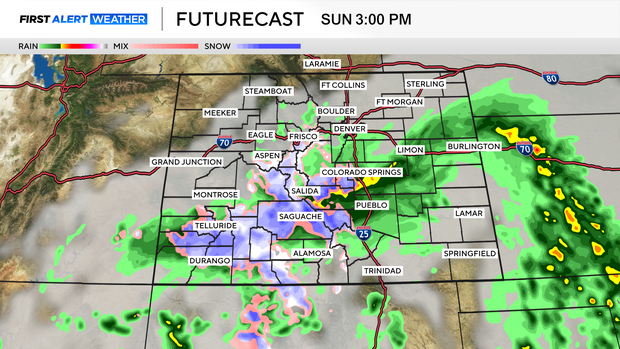On a sunny morning two years ago, a group of state officials stood in the mountains of northwestern Colorado in front of a handful of large metal crates. With a small crowd watching them, the officials began to unlatch the crate doors one by one. Out of each came a gray wolf — arguably the nation’s most controversial endangered species.
Colorado
Boulder International Film Festival celebrates 20 years

Boulder International Film Festival (BIFF) is 4-days jam packed with a whole range of films that will appeal to every audience. The festival has earned a reputation as one of the most innovative film festivals in the nation. This year, BIFF will feature 74 films from 25 countries, two special community events, and the return of many festival favorites.
“I’m most excited about the fact that we have 50 filmmakers coming into town to visit us and see our audiences, and we’re just really excited we’re getting so many filmmakers to come,” said Robin Beeck, co-founder of BIFF.
BIFF kicks off on Thursday, February 29 with the popular CineCHEF 2024 competition. Eight Colorado chefs create dishes inspired by their favorite classic films and then compete for the votes of those in attendance. For the third year, Scott Feinberg of the Hollywood Reporter will be in Boulder with his Awards Chatter podcast. Feinberg will be bringing a special celebrity guest for the recording.
“We’re really excited that Laura Linney will be coming with her latest film called “Wildcat.” It’s a film about the writer Flannery O’Connor. It’s directed by Ethan Hawke. She’s going to come with the film, we’re going to present her with our Vanguard Award, and then we’re going to do an interview with her after the screening,” said Kathy Beeck, co-founder of BIFF.
Opening Night is always a Red Carpet Gala with two parties going on, one at the Hotel Boulderado and the other at Rembrandt Yard. The 5280 Brass Band will lead attendees “second line” style from the parties to the Boulder Theater.
“We’re opening with a film called ‘Ezra’ featuring Robert De Niro. We like to say we’re starting with Hollywood royalty, and it’s a wonderful film with Robert and Bobby Cannavale about a father/son relationship. It’s a dramedy, and it’s incredible,” said Robin Beeck. “We’re closing with a film featuring real royalty called “The Cowboy and The Queen,” about a California horseman who had a great relationship with the Queen of England. She was his biggest fan and it’s so heartwarming. What a wonderful story.”
BIFF is celebrating its 20th anniversary this year, so there is some special programming to thank the community.
“We’ve had so much support over the many, many years, and we want to give back. We’re going to be doing some free screenings at e-Town Hall of some classic films from BIFF. We’re going to show some celebrity clips from over the years before our films, and we’re also going to do birthday cake on the Pearl Street Mall. Who doesn’t love birthday cake?” said Cathy Beeck.
Some other highlights of this year’s BIFF include an adventure film pavilion, the singer/songwriter showcase, and the teen short film competition. You can expect four world premieres, five U.S. premieres, and 18 films made by Colorado filmmakers.
LINK: For Tickets and Information for the Boulder International Film Festival
BIFF runs from Thursday, February 29 to Sunday, March 3, 2024.

Colorado
Colorado has wolves again for the first time in 80 years. Why are they dying?

This was a massive moment for conservation.
While gray wolves once ranged throughout much of the Lower 48, a government-backed extermination campaign wiped most of them out in the 19th and 20th centuries. By the 1940s, Colorado had lost all of its resident wolves.
But, in the fall of 2020, Colorado voters did something unprecedented: They passed a ballot measure to reintroduce gray wolves to the state. This wasn’t just about having wolves on the landscape to admire, but about restoring the ecosystems that we’ve broken and the biodiversity we’ve lost. As apex predators, wolves help keep an entire ecosystem in balance, in part by limiting populations of deer and elk that can damage vegetation, spread disease, and cause car accidents.
In the winter of 2023, state officials released 10 gray wolves flown in from Oregon onto public land in northwestern Colorado. And in January of this year, they introduced another 15 that were brought in from Canada. Colorado Parks and Wildlife (CPW) — the state wildlife agency leading the reintroduction program — plans to release 30 to 50 wolves over three to five years to establish a permanent breeding population that can eventually survive without intervention.
“Today, history was made in Colorado,” Colorado Governor Jared Polis said following the release. “For the first time since the 1940s, the howl of wolves will officially return to western Colorado.”
Fast forward to today, and that program seems, at least on the surface, like a mess.
Ten of the transplanted wolves are already dead, as is one of their offspring. And now, the state is struggling to find new wolves to ship to Colorado for the next phase of reintroduction. Meanwhile, the program has cost millions of dollars more than expected.
The takeaway is not that releasing wolves in Colorado was, or is now, a bad idea. Rather, the challenges facing this first-of-its-kind reintroduction just reveal how extraordinarily difficult it is to restore top predators to a landscape dominated by humans. That’s true in the Western US and everywhere — especially when the animal in question has been vilified for generations.
Why 10 of the reintroduced wolves are already dead
One harsh reality is that a lot of wolves die naturally, such as from disease, killing each other over territory, and other predators, said Joanna Lambert, a wildlife ecologist at the University of Colorado Boulder. Of Colorado’s new population, one of the released wolves was killed by another wolf, whereas two were likely killed by mountain lions, according to Colorado Parks and Wildlife.
The changes that humans have made to the landscape only make it harder for these animals to survive. One of the animals, a male found dead in May, was likely killed by a car, state officials said. Another died after stepping into a coyote foothold trap. Two other wolves, meanwhile, were killed, ironically, by officials. Officials from CPW shot and killed one wolf — the offspring of a released individual — in Colorado, and the US Department of Agriculture killed another that traveled into Wyoming, after linking the wolves to livestock attacks. (An obscure USDA division called Wildlife Services kills hundreds of thousands, and sometimes millions, of wild animals a year that it deems dangerous to humans or industry, as my colleague Kenny Torella has reported.)
Yet, another wolf was killed after trekking into Wyoming, a state where it’s largely legal to kill them.
Colorado Parks and Wildlife has, to its credit, tried hard to stop wolves from harming farm animals. The agency has hired livestock patrols called “range riders,” for example, to protect herds. But these solutions are imperfect, especially when the landscape is blanketed in ranchland. Wolves still kill sheep and cattle.
This same conflict — or the perception of it — is what has complicated other attempts to bring back predators, such as jaguars in Arizona and grizzly bears in Washington. And wolves are arguably even more contentious. “This was not ever going to be easy,” Lambert said of the reintroduction program.
Colorado is struggling to find more wolves to ship in
There’s another problem: Colorado doesn’t have access to more wolves.
The state is planning to release another 10 to 15 animals early next year. And initially, those wolves were going to come from Canada. But in October, the Trump administration told CPW that it can only import wolves from certain regions of the US. Brian Nesvik, director of the US Fish and Wildlife Service, a federal agency that oversees endangered species, said that a federal regulation governing Colorado’s gray wolf population doesn’t explicitly allow CPW to source wolves from Canada. (Environmental legal groups disagree with his claim).
So Colorado turned to Washington state for wolves instead.
But that didn’t work either. Earlier this month, Washington state wildlife officials voted against exporting some of their wolves to Colorado. Washington has more than 200 gray wolves, but the most recent count showed a population decline. That’s one reason why officials were hesitant to support a plan that would further shrink the state’s wolf numbers, especially because there’s a chance they may die in Colorado.
Some other states home to gray wolves, such as Montana and Wyoming, have previously said they won’t give Colorado any of their animals for reasons that are not entirely clear. Nonetheless, Colorado is still preparing to release wolves this winter as it looks for alternative sources, according to CPW spokesperson Luke Perkins.
Ultimately, Lambert said, it’s going to take years to be able to say with any kind of certainty whether or not the reintroduction program was successful.
“This is a long game,” she said.
And despite the program’s challenges, there’s at least one reason to suspect it’s working: puppies.
Over the summer, CPW shared footage from a trail camera of three wolf puppies stumbling over their giant paws, itching, and play-biting each other. CPW says there are now four litters in Colorado, a sign that the predators are settling in and making a home for themselves.
“This reproduction is really key,” Eric Odell, wolf conservation program manager for Colorado Parks and Wildlife, said in a public meeting in July. “Despite some things that you may hear, not all aspects of wolf management have been a failure. We’re working towards success.”
Colorado
Rain and snow roll through Colorado on Sunday

A quick system is rolling through Colorado on Sunday. The mountains will see some snow; however, the northern mountains won’t see much at all. A winter weather advisory is in effect through midnight tonight for Southwestern Colorado, to include the San Juan Mountain Range and Pikes Peak. Four to eight inches is possible, with a foot for the higher mountain passes.
The Denver metro area and Eastern Plains could see some rain showers on Sunday afternoon.
This is a quick system that will clear out overnight, and the work week will start off mild and dry. If you are traveling for the Thanksgiving holiday in Colorado, the weather will be ideal. High temperatures in the Denver metro area will be in the mid- to upper-50s.
All of that changes as we look forward to next weekend. It’s still too far out to have high confidence, but there is a chance Denver could see its first snow next weekend. Even if Denver doesn’t get snow, the temperatures will plummet due to an arctic blast. High temperatures will only be in the 20s and 30s with lows in the teens and single digits.
Colorado
Colorado ski resort ranks among the best in country

-
Business1 week ago
Fire survivors can use this new portal to rebuild faster and save money
-

 World6 days ago
World6 days agoFrance and Germany support simplification push for digital rules
-

 News1 week ago
News1 week agoCourt documents shed light on Indiana shooting that sparked stand-your-ground debate
-

 World1 week ago
World1 week agoSinclair Snaps Up 8% Stake in Scripps in Advance of Potential Merger
-

 World1 week ago
World1 week agoCalls for answers grow over Canada’s interrogation of Israel critic
-

 World1 week ago
World1 week ago2% of Russian global oil supply affected following Ukrainian attack
-

 Politics1 week ago
Politics1 week agoDuckworth fires staffer who claimed to be attorney for detained illegal immigrant with criminal history
-
Business6 days ago
Amazon’s Zoox offers free robotaxi rides in San Francisco

























